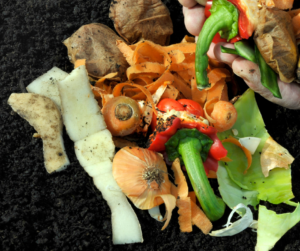Composting is the Ultimate Trash to Treasure
 Composting is recycling at its best! You can take something that you would literally throw in the trash, and turn it into something very valuable to use in your own backyard.
Composting is recycling at its best! You can take something that you would literally throw in the trash, and turn it into something very valuable to use in your own backyard.
So what exactly is composting? It’s a natural biological process where bacteria, fungi, and other organisms decompose organic materials such as leaves, grass clippings, and food waste, resulting in humus. It happens all around us, such as when a tree or branch falls in the woods, it will break down and decay. We can accelerate the process to get the resulting humus faster to use for our benefit. All it takes is a combination of brown waste (carbon) such as fall leaves, dead plant material, then mix with green waste (nitrogen), such as grass clippings, kitchen scraps. You layer them lasagna-like, and it will naturally start to heat up and cook – well, decompose – into humus, a rich soil amendment.
Why would you want to compost? It’s a great way to redirect food waste that might otherwise be put in the trash and go to the landfill. Think of all the raw kitchen scraps you can put to good use: potato peels, lettuce leaves, vegetable ends, eggshells, coffee grounds, and tea bags. Just collect them in a bowl on the counter. There’s no need to buy a special container, just take it out to the compost pile every couple of days. And the resulting humus product is like gold to your indoor or outdoor flowers, vegetables, and most everything that grows. It adds nutrients to the soil, reduces fertilizer requirements, protects plants from disease, and improves root growth for healthier plants with greater yields.
To create a compost pile, you don’t have to purchase or build a compost bin, you can just start a pile on bare ground. Locate an area about 3’x3’x3’ in a place that gets some sun and some shade. Begin with layer of brown stuff, such as dry leaves, sticks, untreated wood shavings, hay or straw, and then add a thinner layer of green stuff, such as fresh grass clippings (*not treated with any chemicals), recently cut plant material, coffee grounds, and kitchen scraps. Gently water between layers (just damp, not puddled). There should be more dead brown material than fresh green material — at least twice as much. Check back in a week, turn it with a shovel or fork if you want to speed up the decomposition, and if it hasn’t rained and the pile seems dry, water it a little.
Things you DO NOT want to add to a compost pile:
- No pet waste or kitty litter
- Stay away from greasy foods, dairy products, meat scraps, and bones.
- Avoid adding citrus peels, eucalyptus leaves, and pine needles
- Do not add diseased leaves and stems from vegetables and flower gardens
If you experience a “colorful aroma,” you probably have one of the items from the “What Not to Compost” list that is decomposing in the pile.
There are several brochures published by Virginia Tech that you can consult to learn more:
#426-703 Making Compost from Yard Waste
#426-704 Using Compost in Your Landscape
#426-711 Building Healthy Soil
You should give composting a try this growing season. Now is a good time to scout around for the perfect spot, and start a bottom layer with readily available brown leaves. What have you got to lose, except those kitchen scraps!
